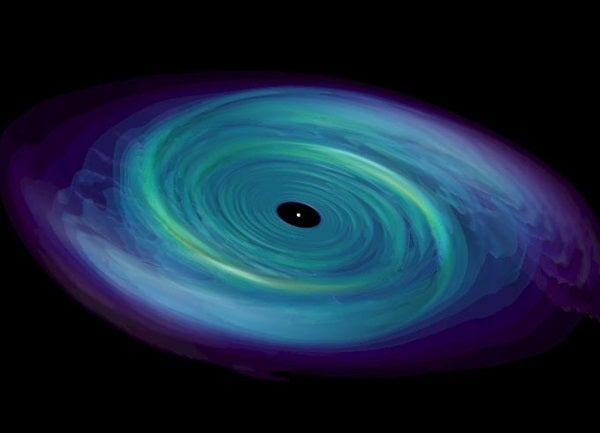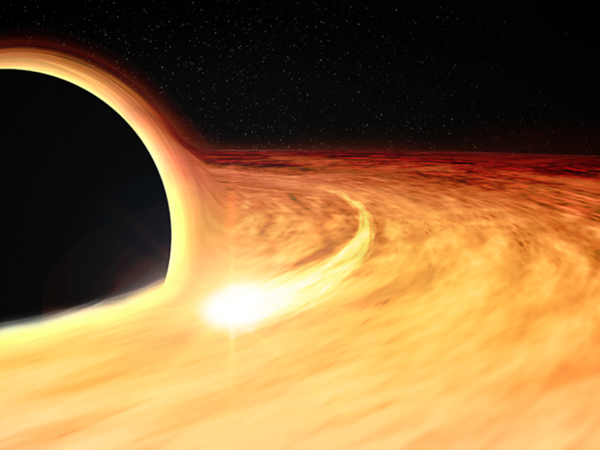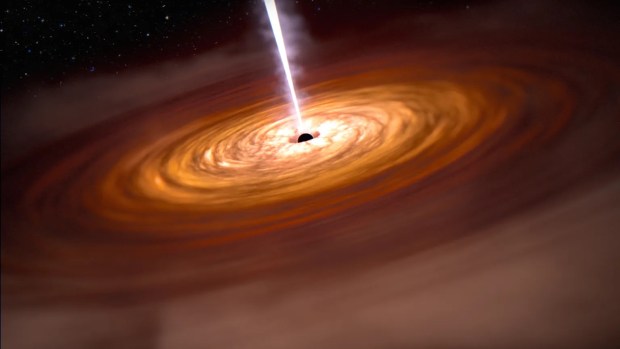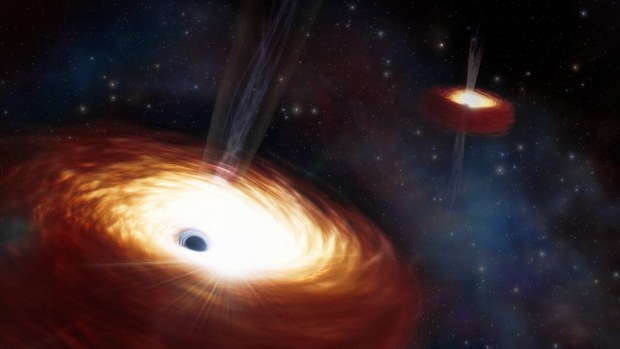Black holes are regions of austere darkness, gobbling up everything — even light — that strays too close. But the environment immediately surrounding a black hole is not so dark. Astronomers often spot copious amounts of light streaming from there, emerging from a thin disk of matter called an accretion disk.
A black hole imprints all of its essential characteristics onto its accretion disk, including its mass, spin, and gravitational field. In the last 10 years, studying the light from such disks has become one of the central methods astronomers use to analyze black holes. And accretion disks supply the only known method for measuring the spin of supermassive black holes, which reside at the center of all large galaxies.
Perhaps the most exotic message sent to us by a black hole’s accretion disk relates to the gravity it feels. In a study published January 22 in The Astrophysical Journal, researchers used X-rays stemming from a black hole’s disk to measure precisely how that black hole’s gravity influences the matter and light nearby. They went on to compare what they found to what they would expect based on Einstein’s well-tested theory of general relativity.
According to general relativity, black holes only have a few major defining features. Two of these are its mass and its spin. (Black holes may also have a third property: electric charge.) These attributes (and these alone) determine the way that the black hole warps space-time around it. And when physicists study the light coming from a black hole’s accretion disk, they gain the ability to effectively “see” the distant invisible object, potentially unveiling these defining characteristics.
Gravity’s whirlpools
“The general picture of the accretion disk is common to many systems,” says Cosimo Bambi of Fudan University in Shanghai, who co-authored the new study. Anything with a significant gravitational field, such as a planet or star, tends to attract matter, which then forms a pancake-shaped ring.
The difference with the accretion disks of black holes is that they are subject to extremely strong gravitational fields. That intense gravity pulls the accreted matter into fast-moving orbits close to the speed of light. And as all this matter scrapes together, unimaginable amounts of friction cause it to heat up to millions of degrees. Those extreme temperatures make the accretion disk glow — not just in optical light, like an oven’s heating element, but with more energetic light as well. Namely, X-rays.
But there’s another catch. When researchers target black holes through their telescopes, they observe so-called “hard X-rays” with 10 to 100 times more energy than expected from collisional heating alone. Physicists have determined that these hard X-rays come from a roughly spherical cloud of extremely hot, billion-degree plasma, called a corona, that encapsulates the black hole. Photons emitted from the accretion disk hit the corona and interact with its high-energy plasma, giving the light even more energy.
These reenergized photons produce remarkable effects on a black hole’ disk. They come from the corona back to the accretion disk, ionizing its atoms and making it fluoresce like a cosmic-scale neon sign. But in this particular case, the atoms emitting the light that astronomers are interested in are iron. These glowing iron atoms produce photons with very particular energies, just as neon signs emit light of a very specific color.
But because the photons have to work their way out of the black hole’s immense gravitational grip, they can lose as much as 80 percent of their energy on their journey. This is known as gravitational redshifting. The photons’ paths are also bent by the black hole’s strong gravity, preventing them from escaping straight out to us. “There are some photons that circle the black hole a few times before they reach the observer,” says Bambi.
So, instead of light with a single wavelength, we observe a broad range of X-rays coming from the accretion disks of black holes, as well as some photons with very specific energies associated with the fluorescence of iron and other elements. By shifting and bending this rich spectrum of colors, even the most mysterious of black holes paints a distinctive picture.
Tracing the spin
Astronomers measure a black hole’s spin by studying how much energy the light from the disk’s atoms have lost (how redshifted they appear). The more redshifted these photons are (the more energy that has been drained from them), the closer in the accretion disk must be nestled to the black hole, increasing the gravitational pull it feels. Yet, the disk can only move in so close before it is completely torn asunder by unparalleled gravity.
It’s the spin of a black hole that determines just how close its accretion disk can get before being destroyed. The orbits of atoms in the disk are most stable when the black hole spins in the same direction as its disk, theory predicts. Moreover, the faster a black hole spins, the more stable its disk. Thus, a rapidly spinning black hole has a tighter accretion disk, which leads to more redshifting and smearing of the light emitted from it. And by measuring this redshift, astronomers can determine the black hole’s spin.
This method has allowed researchers to pin down the spins of numerous supermassive black holes, as well as smaller stellar-mass black holes in binary systems, where a companion star orbits around the black hole. And knowing a black hole’s spin gives us part of the picture of space-time around it, telling us in part how much it’s warping the universe around it, sometimes even dragging space-time along for the ride as it whirls.
Timing the mass
Next comes painting the other half of a black hole’s portrait: Researchers can uncover the mass of a black hole by looking at how the emissions from its accretion disk evolve over time.
“I think what everyone agrees is happening, on the base level, is that you have a variability in the accretion rate,” says Adam Ingram of the University of Oxford. “The amount of mass that’s going onto a black hole, that can vary a lot. These accretion disks are inherently quite noisy things.” That’s because accretion disks aren’t solid — they’re made up of clumps and knots of material, whirling around and around. So, sometimes the black hole gobbles up more material, and sometimes less.
The causes of this noisiness can vary. For example, imagine that a disk suddenly knocks some matter out into its black hole’s corona. That would heat up the corona, sending out a big burst of hard X-rays. When that burst hits the disk, it will in turn emit its own burst of fluorescence. The amount of time it takes for the hard X-rays to move from the corona to the disk is called the light-crossing time.
A larger black hole has a larger light-crossing time, and thus exhibits longer delays between the two flares. And the size of the black hole is directly related to its mass. By measuring such delays, researchers can thus infer the black hole’s mass. For stellar-mass black holes, those delays might only be one or two milliseconds, whereas for supermassive black holes, they might extend to a quarter of an hour.
This technique is called reverberation mass measurement. Ingram and his colleagues used the technique to estimate the mass of a famous galactic black hole — Cygnus X-1 — for the first time in 2019. Cygnus X-1 is perhaps most well-known of all black holes because it was the first object confirmed to be one. “It’s the obvious object to try [reverberation mass measurement] with, because it’s very, very bright, and there’s lots of observations on it,” says Ingram. Earlier estimates had put the black hole’s mass at around 15 solar masses. Those methods examined the orbit of the black hole’s companion star, which is visible in optical light. But using their X-ray measurements, Ingram’s team found that Cygnus X-1’s mass was significantly larger, at around 25 solar masses.
They assumed their results must have some source of error. But in a paper published March 5 of this year in Science, researchers revised the black hole’s mass measured with the earlier, well-established techniques to at least 21 solar masses. That’s in line with Ingram’s measurement, which, he says, demonstrates the pioneering abilities of reverberation-based methods for measuring black hole mass.
Testing the field
Knowing a black hole’s mass and spin tell us most everything we need to know about it. But perhaps the most tantalizing goal for astronomers remains measuring the strong gravitational field near a black hole. While general relativity predicts the strength of this field, many physicists think Einstein’s theory — which explains how the universe works at the largest scales — might be flawed. That’s because physicists are currently unable to reconcile the differences between how general relative and quantum theory predict matter should behave at the smallest scales.
Motivated by these problems, Bambi and collaborators recently measured the strength of the gravitation field around a black hole binary system called GX 339–4. This system has an unusually active accretion disk, exhibiting strong outbursts of light every few years. That’s why two X-ray telescopes, NuSTAR and Swift, simultaneously observed the disk in 2015.
Critically, the two telescopes measured both ordinary X-rays and redshifted fluorescence emissions at the same time. The team then reproduced the observations using simulations that combined two codes — one to produce each type of emission. Their results show that the predictions of general relativity are right on track. And although there is a slight hint of deviation, it’s so small that the researchers think it’s likely due to natural statistical error rather than real effects.
To get measurements of general relativity that are even more precise, Bambi says, will take the next generation of astronomical facilities. These are instruments like the European Space Agency’s Athena X-ray observatory, set to launch in 2031. Athena will allow astronomers to take even more accurate measurements of accretion disks, potentially finding any still-hidden flaws in general relativity.
That is, if any flaws are there at all.












